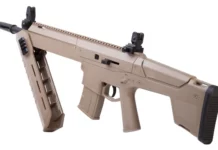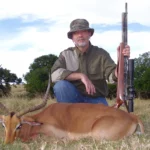In times past, hunters found a hunting companion dog invaluable. The most popular small hunting dog breeds include the Beagle, French Brittany, American Water Spaniel, Brittany Spaniel, and Nova Scotia Duck Tolling Retriever. Not only did a hunting companion dog help to flush the game out of bushes, shrubs, trees, or even water, but the hunting companion dog would also retrieve much of the game for the hunter. In some cases, hunting companion dogs would assist in finding a felled game that had somehow gotten out of sight of the hunter. Prior to the hunt, these same dogs would help to track potential games.
I myself have witnessed hunting dogs in action and it is a pretty amazing sight. Hunting companion dogs make the activity a little more exciting, especially when they “tree” or “point” out a potential game. I listed 8 of the most common small hunting dog breeds including the facts about them below.
Table of Contents
What are eight hunting dogs that are smaller in size?
There are eight hunting breeds that are considered small dog breeds. They include:
- the Beagle
- the French Brittany
- the American Water Spaniel
- the Brittany Spaniel
- the Nova Scotia Duck Tolling Retriever
- the Small Munsterlander
- the Cocker Spaniel
- the Boykin Spaniel
The Cocker Spaniel
Named after the bird that the breed was utilized most to hunt, the Cocker Spaniel is one of the best hunting dogs for many reasons.
Although the Cocker Spaniel is a small dog, they truly shine when they perceive prey is in the thickest of cover. They pounce with all the bravery their tiny bodies can contain, and they would flush out a game with great enthusiasm. They are great bird hunting dogs, also called a gun dog. When trained properly, a Cocker Spaniel can be a versatile hunting dog.
The Cocker Spaniel was chiefly utilized to hunt the woodcock. The Cocker Spaniel is a very energetic dog that loves to work. Plus, he’ll work all day if you provide him with the opportunity.
There are two variations of Cocker Spaniel—the English and the American. One can only tell a slight difference in the head shape of the Cocker Spaniel. However, American Cocker Spaniels tend to be friendlier than their English counterparts.
The Cocker Spaniel is considered one of the smallest hunting dog breeds today, but, typically, they are house pets rather than hunting companions. This breed is typically between 13.5 to 15.5 inches (this includes averages for both males and females; the male Cocker Spaniel will measure on the larger end of those numbers). The Cocker Spaniel will usually weigh between twenty to thirty pounds.
The American Water Spaniel
You might recognize the American Water Spaniel due to its curly hair. Aside from that, this dog breed is also known for its ability to flush game out of water. They are described as “flusher dogs” but they also retrieve fallen games, as such, they tend to work closely with their hunter handler.
The American Water Spaniel is considered quite versatile, but the breed is highly inclined to retrieve. Although athletic as well as enthusiastic, the American Water Spaniel can be somewhat stubborn as well as shy around new people.
I you are looking for a canine generally able to hunt, flush out, and retrieve waterfowls, The American Water Spaniel is a good candidate. They also have a highly dense and waterproof coat that makes them perfect for such work.
The American Water Spaniel is one of the most intelligent dog breeds I have encountered, that is full of energy as well as a tad bit of stubbornness. It is important to keep the breed active in order for the dog to be happy.
It is also important to begin training the American Water Spaniel as early as possible. Overall, the breed is obedient and friendly when trained properly.
The American Water Spaniel male is between thirty and forty-five pounds at adulthood; the female is much smaller, weighing twenty-five to forty pounds when fully grown. This breed typically stands between fifteen and eighteen inches at adulthood.
The Beagle
The Beagle is one of the most popular small hunting dog breeds—or even one of the most popular dog breeds, period. They are hounds at heart, so they love tracking scents and they enjoy flushing out prey. The Beagle is a highly diverse hunting dog as they are originally bred for hunting smaller game such as rabbits and foxes, but I’m quite impressed that they are also useful for hunting large games such as deers.
Another reason why the Beagle is highly popular is because of its happy-go-lucky attitude. I love how these pups are both fun and smart. They can be taught to retrieve even though it is not their chief inclination.
Did you know that the Beagle was first used to hunt rabbits, and the style of hunting used for this purpose was called “beagling”? They work well in pairs, and typically, they flush prey out of thick underbrush.
The Beagle is a gentle and friendly breed that loves to interact with its hunter handlers. Training the Beagle should begin when they are fairly young. As a hound breed, they can be stubborn, but consistent training should overcome any obstinate behavior on the part of the dog. Beagles are one of the small hunting dog breeds that love to interact with children, too.
Like other hunting dogs, the Beagle needs a certain amount of activity each day in order to remain happy and healthy.
The Nova Scotia Duck Tolling Retriever
Known as the “Toller”, the Nova Scotia Duck Tolling Retriever is one of the smallest retrieving dogs. Some will relate that the Nova Scotia Duck Tolling Retriever has a high-pitched “scream” that sets them apart from other hunting dogs.
The Nova Scotia Duck Tolling Retriever is especially attuned to hunting in cold weather, and their coat protects them from the harsh, cold water. These dogs are chiefly retrievers but they are good flushers too, and were named for the way in which they would assist their human hunting handler in “tolling” ducks.
These brilliant water dogs are best utilized for hunting waterfowl. However, they often worked to lure ducks in range of their human handler so that the hunter could get an accurate shot on the prey. They are especially useful for this job because they are very alert and an extremely intelligent breed. They are also highly patient. Like other retrieving dogs, they depend greatly on signals from their human hunting handlers.
The Nova Scotia Duck Tolling Retriever is quite active, and, if human handlers do not offer the Toller the best balance of activity, the Toller can become destructive. Remember, as natural hunters and retrievers, the Toller is happiest when he is busy—or very tired from a busy day.
Just a little reminder: the Toller can be less submissive than other retrieving dogs. They tend to be less friendly with strangers.
The Nova Scotia Duck Tolling Retriever stands anywhere from seventeen to twenty-one inches in height. Typically, regardless of whether the dog is male or female, the Duck Toller will weigh between thirty-five and fifty pounds.
The Boykin Spaniel
Although considered a small hunting dog, the Boykin Spaniel is in fact larger than the breeds on this list. Having a dense coat that protects their body as they swim in the water of varying temperatures make them resilient hunting canines.
The Boykin Spaniel is a great flusher of game. However, they are known for taking their sweet time before they actually flush the game out. They do not need their human handler to offer commands before taking action. They are extremely versatile dogs, being highly adept retrieving dogs as well.
Hunting both pheasants and quail is what the Boykin Spaniel is exceptional at, but they are also used for flushing out and retrieving waterfowl. I love how this breed utilizes both scent and sight for the tracking game.
Not only is the Boykin Spaniel a great hunting companion, but the breed is a wonderful family pet as well. The Boykin tends to get along well with all people, even strangers. The breed is very smart and they simply enjoy hard work. They are also great companion dogs outside the hunting field.
The Boykin Spaniel tends to be between fifteen inches to eighteen inches in height at adulthood, and weighs an average of twenty-five to forty pounds at adulthood.
The Small Munsterlander
The Small Musterlander is a dog of German origin; it is not related to the Munsterlander other than they come from the same area in Europe. This breed is known for its ability to do just about anything. You’d be glad to know that they can be easily trained to flush out, retrieve, and point prey. This is thanks to their natural attentiveness and being extremely intelligent.
These dogs are so versatile that they are equally adept hunters on both lands and in the water. The Small Munsterlander hunts just about any type of fowl a hunter can imagine. They are adept at hunting waterfowl, ducks, and the like, but they are also great for hunting upland birds.
The Small Munsterlander is typically twenty to twenty-one inches in height and normally weighs between forty and sixty pounds. I suggest doing a great deal of DIY dog grooming to maintain these dogs.
The French Brittany
The French Brittany is very similar to the American Brittany spaniel in its hunting style. They are known for their scent tracking abilities as well as their ability to point both upland birds and waterfowl.
Not only is the French Brittany versatile hunters—they are highly intelligent and friendly too. This makes them great family dogs as well as great competition hunting companions.
The French Brittany typically stands between seventeen and twenty inches and they weigh between thirty and forty-five pounds.
The Brittany
The Brittany Spaniel is a gundog whose initial purpose was as a hunting companion. Known for its penchant for pointing as well as being a flushing dog, this breed is versatile, strong, and highly intelligent.
I find it wonderful how they can be both great family dogs and highly adaptable hunting companions at the same time. Brittanies love to hunt a wide variety of games [1].
The American Brittany Spaniel is usually just over seventeen inches to just over twenty inches in height, and the average weight of a Brittany Spaniel is between thirty to forty pounds at adulthood.
FAQs
1. What is the smallest breed of dog used for hunting?
The Cocker Spaniel is one of the smallest breeds of dogs that were once utilized as hunting companions. However, the Cocker Spaniel of today is more of a companion animal than a hunting companion.
2. What is the smallest upland bird dog?
The Small Munsterlander, a German dog with a tendency to work as a pointer, is the smallest upland bird dog.
3. What is the easiest breed of hunting dog to train?
Golden Retrievers and Labrador Retrievers tend to be the easiest to train. Both breeds look to their handlers for directions and they work well with their human hunting companions.
4. What is a good hunting dog?
A good hunting dog is one that listens to commands, hunts enthusiastically, and is energetic on the hunting field.








































